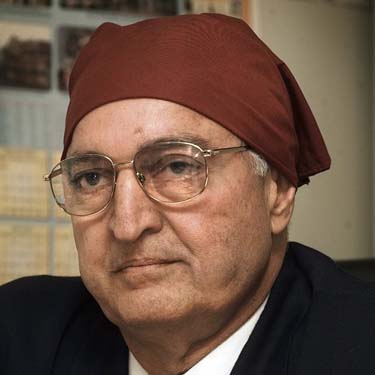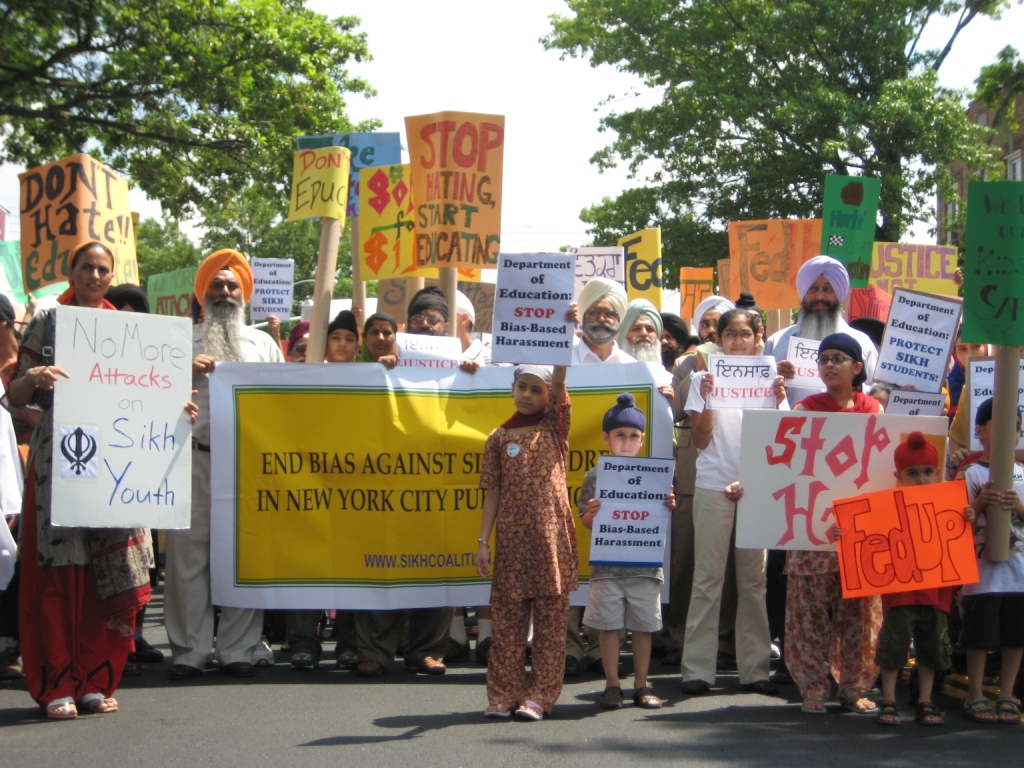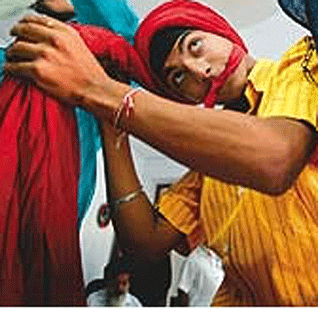
For many Sikhs the name Sumedh Saini rings a solemn tone. Part of a handful of high police officials, Saini was the Superintendent of State Police in Chandigarh during the Troubles in Punjab. He reigned with fear, terror, and impunity.
 While the wheels of justice may be slow, the Central Bureau of Investigation (CBI), India’s premier investigating agency, has just released its indictment of Sumedh Saini. Saini has recently been indicted for abduction, illegal detention, and other offenses. While the charges pale against the thousands of ‘eliminations,’ for some they are taking solace for the CBI’s findings.
While the wheels of justice may be slow, the Central Bureau of Investigation (CBI), India’s premier investigating agency, has just released its indictment of Sumedh Saini. Saini has recently been indicted for abduction, illegal detention, and other offenses. While the charges pale against the thousands of ‘eliminations,’ for some they are taking solace for the CBI’s findings.
Total of four people were indicted by the CBI on Friday:
State Vigilance Bureau chief Saini, retired former Chandigarh DSP Baldev Singh Saini, Chandigarh SHO (Station House Officer) and ex-subinspector Harsahai Sharma and former subinspector now SHO Jagir Singh [link]
The findings are significant in face of his plum appointed position by Punjab Chief Minister, Parkash Badal, who had raised him to the head of the state’s Vigilance Bureau. While it will have little political traction, it points to the hypocrisy of the ‘banana republic’ that is the state of Punjab where the head of a bureau meant to guard against corruption is now being indicted for falsely arresting and torturing the state’s citizens.
Mr Saini is currently leading the Parkash Singh Badal government’s campaign targeting former chief minister Amarinder Singh and his associates. The CBI’s charges against him have come as certain embarrassment for the chief minister. [link]
It is still to be seen what will come from all this, will Saini actually be convicted and punished for his crimes? or will this just be another CBI indictment?
UPDATE: Although this post is over 5 months old, I thought I would give an update on the current case. It seems The Herald, a Catholic newspaper in Malaysia, has filed a lawsuit against the Malaysian government’s attempt to ban the usage of the word “Allah” by non-Muslims. The Malaysian Gurdwara Council (is this a real organization or a one-man show, can any of our Malaysian readers fill us in as I couldn’t find any information) has added their name to the lawsuit. Again, I revisit the question, can any one religous community claim a monopoly on its religious vocabulary? How about iconography?
———————————————————————————-
The Sikhs have a long, proud, and distinguished history in Malaysia. While Sikh traders began arriving in South East Asia, during the Mughal period, the Sikh numbers markedly increased under British imperialism.  Sikhs were often settled throughout the colonies as police men and later took a lead role in the transportation industry. Their presence and connection to Punjab has been strong throughout the past and the Khalsa Diwan Malaysia took an active role in ratifying and creating the Panthic Sikh Rehat Maryada during the early years of the 20th century. The Sikh Naujawan Sabha Malaysia remains a leading example of a diasporic Sikh organization.
Sikhs were often settled throughout the colonies as police men and later took a lead role in the transportation industry. Their presence and connection to Punjab has been strong throughout the past and the Khalsa Diwan Malaysia took an active role in ratifying and creating the Panthic Sikh Rehat Maryada during the early years of the 20th century. The Sikh Naujawan Sabha Malaysia remains a leading example of a diasporic Sikh organization.
Despite the Sikhs’ prominent standing in Malaysian society and the relatively secular nature of Malaysian Islam, it is of some note that the government recently moved to have the words “Allah” (God), “Kaabah” (Worship center at Mecca), and “Solat” (prayer) banned from non-Muslim literature and speech.
While I would guess Christian evangelism (Christians in Punjab love to call Jesus ‘Satguru’ and have ‘kirtans’ in his praise) was the main target of such legislation or appeasement towards certain political parties and groups, I am not sure what will be the impact for Sikhs due to our community’s unique lingual affinities with Islam.
Is it just me or are we seeing Giddha increasing in popularity these days?
Giddha was the folk dance of choice for our Grandmothers and Mothers. It allowed them a platform to get together with other women, and through boliyan talk openly about their daily lives. I asked my Mum if this was a form of therapy for them, and she said “yes”. It was a release for these women to be able to have this time for themselves and openly release supressed feelings in a joyful manner.
We see a great number of young women in Universities joining the “Bhangra” team and peforming these rather masculine dances at Bhangra competitions. Where is our traditional Giddha? I found this video which shows a performance by the UC Davis Giddha Squad at a competition this year. It was nice to see that these girls decided to create some uniqueness to the monotony these Bhangra competitions have began to display. Hopefully this will be a continuing trend and we will see more incorporations of Giddha for women at University levels. There is a sense of elegance and femininity that Giddha has, and which Bhangra lacks for women.
I look forward to the day when young girls are able to immerse themselves in Giddha and learn Boliyan and truly appreciate what our culture has to offer. Maybe we will see a Giddha Academy some day? I am hopeful.
With Teeyan season upon us, we can take the first step in going and attending these events in our areas. In the California we have these events scheduled annually and it’s become larger every year. Please make sure to attend if you know of Teeyan happening in your area. It would be a great way to take your Grandmothers, Mothers, Aunts, Sisters, Daughters, and Friends out to spend an afternoon together. (And it’s a great workout!)
How do you all feel about this subject? How can we begin to make a progressive change towards incorporating Giddha into the lives of younger women?
Recently I was having a conversation with a non-Sikh about names and how you can tell the gender of a Sikh individual just by looking at their name. I told her that there really wasn’t a fool-proof way of doing this since many Sikh names can be used by both men and women. However, I told her, when you see “Kaur” and “Singh” used in the name, you have a better chance of identifying the gender since it tells you if the individual is female or male, respectively. (Just to confuse her, I did mention that Singh is often also used by women). We were later joined in our conversation by another Sikh woman who basically refuted my explanation of Sikh names by telling our non-Sikh acquaintance that in fact, she and a growing number of Sikhs in our community actually don’t use “Kaur” and “Singh” at all in their name. The whole conversation reminded me of another similar discussion I happened to have with a Sikh friend of mine who, having married a non-Sikh, said that she had no intention of using “Kaur” or “Singh” in the names given to her children.
Now, while I realize that these are two unconnected conversations and I am by no means suggesting this is a trend of any sort – I do wonder how common this is and what (if anything) it means for the Panth. If, for example, my friend chooses not to raise her children Sikh, then I feel ike it is less problematic that she does not use “Kaur” and “Singh” in their names. However, it is interesting to me when people who identify themself as Sikh choose to shed this identity. I am aware that a name by itself does not necessarily establish an identity. However, I wholeheartedly believe that having “Kaur” and “Singh” bestowed upon us by our Guru was no small thing and in fact, it does establish an identity for Sikhs. By not continuing to use “Kaur” and “Singh” in the names of Sikhs, how much of our identity is being diluted? I do believe that there are enough Sikhs who are conscious of this. Many young Sikh women, including myself, who use “Kaur” as a last name now intend to keep it as a last name after they get married. This is also a significant step in solidifying one’s identity.
Thoughts on this?
It’s men like David Addington and John Yoo that give lawyers a bad name. Addington was Vice-President Cheney’s enabler. Yoo authored the infamous torture memo stating that in order to qualify as torture, pain (resulting from interrogation techniques used on detainees) had to reach a level produced by ‘death, organ failure, or permanent impairment of a significant bodily function’ (see bottom of page 38 of the memo). The memo was later withdrawn and eventually released as part of an ACLU lawsuit, forcing the Bush administration to turn over documents related to the war on terror [link]. Together, these two men are considered the chief architects of the “enhanced interrogation techniques” implemented by the Bush administration.
They were subpoenaed to testify in front of the House Judiciary subcommittee recently regarding detainee treatment, interrogation techniques and their views on Presidential power. They stuck by a strategy to reveal nothing, basically wasting the Judiciary subcommittee’s time (which Congressmen pointed out).
One thing that distresses me about their testimony and this administration is that they make a mockery of the dream that brought my parents to the US. My parents left India after 1984 seeking shelter- a place where government officials didn’t violate the fundamental rights of the people and where officials were held accountable for their actions. They came to the place where Nixon handed over incriminating tapes upon order of the Supreme Court, with the entire American army at his command. Even if their dream was romanticized before, now it’s a joke. Yet my father is as stoutly patriotic (of his adopted country) as ever.
It was reported this week that a Court in Belgium has overturned a ban that had been established for five Sikh students wearing Patkas. This case began in May 2005, when these Sikh students were banned from attending KTA Domein Speelhof school in Belgium due to the implementation of a new uniform rule banning head coverings.
The court said that the ban on the religious head covering was a violation of the Sikh students’ right to manifest their religion under article 9 of the European Convention on Human Rights, of which Belgium is a signatory.
In a judgment handed down today, Judge Madam H. Coenen said that by excluding young people because of their religious beliefs the Domein Speelhof school in St Truiden had violated their right to practice their faith.
United Sikhs took up this case and are applauded for their great work.
The news comes at a time when our community is faced with many cases of injustice for practicing our faith as Sikhs. This is a positive step and shows that the fight for our rights as Sikhs is not a lost battle. It will take time, but we are progressing toward educating people who we are as a community. There are many more cases to be fought, but we will persevere.
Few of us are probably well versed in Afghani music, unless you’re in close proximity to a sizeable Afghani population, or unless you have Afghani friends. I don’t know if I’ve ever heard any, except maybe in independent films. (On a side note, how many Afghanis even consider themselves Afghani instead of Pashtun, Tajik, Hazara, etc.?)
Soon, we’ll be able to hear an Afghani-Punjabi fusion album…
Amritsars [sic] playing host to two Afghan singers who are shooting for an Afghani-Punjabi music fusion album. Ariana Sayeed, a London-based Afghan female singer along with Germany-based Afghani singer Javed Sharief arrived here to shoot the first Indo-Afghan music album. The album titled ‘Second Chance’ contains four songs, two of which are duets in Afghani and Punjabi sung by Javed Shareif and Holland-based Punjabi singer Balli Kalsi. [link]
In theory, this sounds like it could be really interesting, even for those who normally dislike fusion music. I bet folk music from the two regions, mixed, would be beautiful. However, a quick glance at Balli Kalsi, and a glimpse into the artists’ intent shows that this album, which may have had potential in someone else’s hands, is more likely to just be offensive to the intended audience.
Sorry for my long absence. Expect an explanation post very soon.
Although there is more current news, there are two past due topics that need to be discussed in The Langar Hall. I begin with the first.
Hall. I begin with the first.
Now while Mack-10’s lyrics in the title of this post may not be completely appropriate, I use them to highlight a possible historic event in the Sikh community in Canada and beyond.
For those of us that grew up in the states, the Dasmesh Darbar of Surrey and the Guru Nanak Sikh Temple of Surrey entered our popular imagination in 1998 when Sikhdom was shaken by the inane “tables and chairs” controversy. A local Surrey conflict soon ballooned throughout the world and even saw violence at a number of different Gurdwaras in North America and Europe. A conflict, which most did not understand, divided local communities and caused rifts that still fester within the Sikh community today.
The worst-affected area was where the controversy initially began – Surrey, Canada. A new vocabulary entered into the language of Sikh-British Columbians: “fundies” verses “moderates.” A generation of Canadian youth saw rishtas broken and dinner conversations centered around “uthay ja thalay” (“up” or “down”).
 I’ve mentioned before how much I enjoy belonging to such a pro-active community. I don’t know whether it’s the Punjabi, the Sikh, or some combination of the two influences that makes people speak out, but whatever it is, I love it.
I’ve mentioned before how much I enjoy belonging to such a pro-active community. I don’t know whether it’s the Punjabi, the Sikh, or some combination of the two influences that makes people speak out, but whatever it is, I love it.
This picture, I think, portrays why. It speaks volumes. Hundreds of men and women of every age group walked together and made their voices heard in Richmond Hill today.
“Don’t Hate, Educate” and “Fed Up” (says the chotu in the front row on the right).
The girl in the front, center stole a piece of my heart too.
From the Sikh Coalition:
REMINDER– If you’re in the New York area, take the morning off work/school on Monday and join the Sikh Coalition in a march to end harassment against Sikh students in public schools:
When: Monday, June 30th, 11:00AM
Where: Meet at Sikh Cultural Society: 95-30 118th Street or Gurdwara Baba Makhan Shah Labana: 113-01 101st Ave.
Why: 1) Sikh students have a right to attend school without fear of harassment for being Sikh, and 2) you can help future students have a better experience in school than you, your siblings, or your friends may have had!
————————————————————————————–
The violence against Sikhs in New York that the Sikh Coalition tracks, and reports is a representation/reflection of the violence that young Sikh students undergo in many areas of the US. In areas where we don’t hear about such violence, it’s not because it doesn’t occur, but because organizations like the Coalition don’t exist to track, report and respond to the violence.  Ideally, we should all be able to respond to the needs of our local community, and I hope that we are building the capacity to do so in the near future. In the New York area, the Coalition is responding.
Ideally, we should all be able to respond to the needs of our local community, and I hope that we are building the capacity to do so in the near future. In the New York area, the Coalition is responding.
In the latest of a spate of attacks on Sikh students in New York, 12 year old Gurprit Kaur had part of her braid cut off and thrown in the trash. This occurred about a little over a year after another student’s hair was forcibly cut in the New York area in May of 2007. In response to the series of attacks on Sikh students in the New York (especially Richmond Hill) area, in the face of inaction by authorities after the group’s troubling findings on harassment in the school system, the Coalition is organizing a march on Richmond Hill High School. [Click on flyer for details.]
A blogger recently mentioned that many of us switch back and forth between English and Punjabi in conversations, and how it’s sometimes more comfortable to speak Punjabi. Have you thought about how your mental frame of reference shifts when you switch languages? Do you think this affects your personality? A recent study seems to think so…
Bicultural bilingual individuals have incorporated two cultures within themselves and speak the languages of those cultures. When cued by a particular language, these individuals activate distinct sets of culture-specific concepts, or mental frames, which include aspects of their identities. Three studies show that language-triggered frame switching (i.e., switching from one set of mental frames to another) occurs only with biculturals, not with bilinguals who are not bicultural. The studies uncover frame switching at the within-individual level, and they include both qualitative and experimental evidence. They also provide a methodology to identify the relative activation strength of specific mental frames in different languages. [link]
Researchers found that women classified themselves and others as more assertive when they spoke Spanish than when they spoke English. The study was based partly on women’s reactions to television commercials shown in English and Spanish.
One part of the study got the volunteers to watch TV advertisements showing women in different scenarios. The participants initially saw the ads in one language – English or Spanish – and then six months later in the other… “In the Spanish-language sessions, informants perceived females as more self-sufficient and extroverted,” they say… For example, one person saw the main character in the Spanish version of a commercial as a risk-taking, independent woman, but as hopeless, lonely, and confused in the English version. [link]
I haven’t read this paper yet so I don’t know the entire methodology, but from the TV-ad experiment, I wonder if the perceived assertiveness is a reflection of the level of comfort within the culture that the individual was responding to. If you’ve noticed a shift in mental frames when you switch from English to Punjabi (or French, or whatever else you speak), how does the shift in mental frame affect your personality?
SCORE has already come under scrutiny here in The Langar Hall, and I don’t wish to scrutinize the entire organization further. But their list of honorees from the 2008 Heritage Dinner does deserve some attention. This year, the following individuals were honored:
1. Sandeep Singh Caberwal, a Sikh entrepreneur in Silicon Valley and a model, wears a turban, has a beard and was chosen by designer Kenneth Cole in its recent fashion campaign
2. Ms. Tami Yeager and Preetmohan Singh for their film documentary “A Dream in Doubt,” which explores the real life story of Rana Singh Sodhi’s family, whose brother was murdered as the first hate crime victim in AZ in the 9/11 aftermath
3. Darshpreet Singh, a recent graduate of Trinity University in San Antonio, Texas. was co-captain of the Men’s Basketball team and fan favorite, and believed to be the only turbaned Sikh to play in a National college basketball game
4. Dr. Jagjit Singh Khalsa is the Chief of Medical Consequences of Drug Abuse at the US National Institutes of Health
5. Gurvendra Singh Suri, founder & CEO Optimal Solutions Integration, Inc., a successful technology consulting Company in Dallas, TX
6. Raghbir Singh Subhanpur, business owner from New York and President of New York Shiromani Akali Dal was honored with Community Service award
7. Surinder Singh Chawla, Nassau County Human Rights Commissioner, was honored for Social Activism and Service
8. Ro Khanna, an Indian American political activist from California was also honored for his role in supporting Sikh issues. [link]
Readers, what strikes you as odd about this list? . . . The only woman recognized is American. How is it possible that no Sikh women made any noteworthy contributions to the Sikh or American community in the past year? (There seems to be an attempt to recognize contributions to both Sikh and American, non-Sikh communities.) Let me tell you- it’s not.
I found this interview with the revered Fauji Singh ji, after completing the Edinburgh daur- a mere chabi (26) miles to be so endearing.
He has a message for the nau-jawan and at the end (it kind of got cut off, but he seems happy that the nau-jawan, both boys and girls, are running these days)…

The UK has been hit with a recent controversy over expenditures, allegedly upwards of £100,000, spent on finding appropriate anti-terror gear that could accommodate the Sikh turban. A good deal of this was spent taking the officer away from duty and asking him to approach equipment manufacturers himself to request accommodated gear. Shortly after this search period expired, he took a leave in order to cope with the emotional stress of this experience.
Two very salient arguments are made: One side argues that such cost was a “waste” and took the officer in training away from assignment (he was in limbo — he was not able to serve with the regular police, but without a uniform could not get full clearance to serve with anti-terror specialists). The other argues that the officer is sorely needed, that the county he hails from is actively trying to diversify its anti-terror police force, and that the cost is worth it if it paves the way for other ethnic and religious minorities to feel comfortable trying out to join the anti-terror squadron.
I think there’s validity to both arguments. Accommodation, especially in democracies, ought to be a key value in integrating diverse communities. That said, it sounds like the UK (or local) government did not take the issue of diversity seriously. The problem is not in the £100,000, per se, it’s in the failure of the state to actively support, or deal seriously with, the issue of Sikh guards.
But is there ever a (monetary) limit to accommodation? How do we find that limit? Is it a simple cost-benefit analysis, or are there other, more weighted, measures that come into play? Was it the money itself, or the poor management of said money?
 Could the community’s recent rallying in response to hate crimes have similar results (though in smaller proportions) as was seen after Operation Bluestar of people re-committing to their faith?
Could the community’s recent rallying in response to hate crimes have similar results (though in smaller proportions) as was seen after Operation Bluestar of people re-committing to their faith?
Many Sikhs today, unfortunately, cut their hair at some time during their adolescence. This is seen amongst Sikhs who are isolated in communities that have little or no exposure to Sikhs (or sometimes anything outside of that particular community) but also in communities with large numbers of Sikhs.
It seems that at least in New Jersey, the increasing number of Sikhs along with recent media exposure is alleviating at least one of the reasons that kids decide not to keep the Sikh roop.
Despite the recent brutal harassment of a high schooler in New Jersey which made international (Indian) news, some Sikhs in Jersey feel that awareness of Sikhs is growing. The media campaign after the incident has also probably contributed to increasing awareness in the area.
Apparently the police have arrested over 70 Sikhs in Mumbai for vandalizing MTV’s headquarters there. The reason for the protest and vandalism? Apparently MTV’s poster promos featured a sardarni massaging a man, which they found offensive to the faith community and its principles.
Now, I typically do not advocate vandalism or violence as a means of protest, but I think this incident brings up a larger issue around representation, especially for minority communities. Is it possible that there is a Sikh girl, somewhere, who is a masseuse? Probably. However, the issue at hand is whether or not such a representation is offensive to the teachings of Sikhi (I have not seen the poster, so I can’t comment on how salacious it is), and if so, what an appropriate response would be.
Like many other minority communities, Sikhs face a unique task in trying to combat stereotypical and lampooned representations in the media while dealing honestly with the diversity of experiences and viewpoints within the broader faith community. This event, while very different, reminded me of the gurdwara incident in the UK a few years ago. Many feel that it is dangerous to “indulge” negative representations because they tend to produce new stereotypes or to violate the ethic core of the community (a good example of stereotypical Sikh representations would be the buffoon/drunkard or villain/nemesis in Bollywood films). So, if this poster was offensive, how should the community have dealt with the issue? I don’t know if they had tried other tactics (e.g., letter writing, phone calls, non-violent protest), but then again, it’s not hard for a non-violent protest to turn to vandalism or other outward action.
In the U.S., SMART (now SALDEF) originally started as an organization to combat misleading and incorrect stereotypes in American media. The Mumbai case is different on many fundamental levels: Sikhs are a much larger and much more visible minority in India, there is less of an “excuse” for ignorance on the part of national media networks (or international, in this case). However, it doesn’t seem like there’s a great mechanism for dealing with incidences like this.
How can Sikhs work to balance negative representations against the reality of community issues without recasting themselves as another stereotype or caricature?
 For a place that makes money off turban-wearing and multicultural disney characters, it seems a little ironic that a turban-wearing employee of Walt Disney would be fired for not having the “Disney look.” Uhh what?
For a place that makes money off turban-wearing and multicultural disney characters, it seems a little ironic that a turban-wearing employee of Walt Disney would be fired for not having the “Disney look.” Uhh what?
This story has been getting a lot of press lately (so for the two of you who haven’t heard) Sukhbir Channa applied for a job (as a trumpet player) with Disney in September 2006 but was told that he couldn’t be hired unless he removed his religiously-mandated turban. He was told that he did not conform with Disney’s grooming and dress requirements known as the “Disney Look.” (Okay, but Aladdin does?) Our friend over at SikhSwim makes a good point,
On my last visit to Disney World, little kids, when they saw me, would say, “Hey look, it’s Aladdin!” So I think Disney’s position has no basis. I think Sikhs have the “Disney look” if average people confuse us for some of the popular Disney characters! [link]
SALDEF has stepped in to help Channa with his lawsuit,
“Disney’s position is fundamentally un-American because it forces Sikhs and also observant Jews and Muslims to sacrifice religious freedom in order to pursue their career goals,” said SALDEF Chairman Manjit Singh. “It is also hypocritical for Disney to make millions of dollars promoting cartoon characters that wear turbans and simultaneously reject the right of an employee to wear a turban in accordance with his faith.” [link]
Having earned a bachelor’s degree in music, Channa just completed a nine-month U.S. tour with the Broadway show Annie. We’ll update you as soon as we hear more about this story. In the meantime, what are your thoughts on this and am I the only one impressed that we know a Sikh trumpeter?!
Revolutions come in strange shapes. Sometimes ‘French,’ sometimes ‘Islamic,’ other times ‘American,’ and maybe even ‘Russian.’ Closer to us, they may even be ‘Sikh.’ However, they may even be in the form of a carbohydrate.
During the 16th century, an expansionist Spain accidentally found itself in the ‘New(?) World.’ Armed with firearms, but mainly syphilis, the Conquistadors devastated a continent and saw the near annihilation of the native people. Along with the silver wealth brought back to Europe came the potato.
While the history of the potato is a famous story in its own right, the potentiality of the potato is becoming more impressive for a number of different policy makers. Recently the world stage is beginning to forecast a “food crisis” in the making. Those of us that keep an eye on Punjab and the rest of the world should begin paying more attention to the growing ‘food crisis.’ With an expanding world population and increasing consumption, some experts are predicting increasing global insecurity. An agrarian-sensitive Punjab would feel the repercussions of such insecurity manifold.
 72 year old Balwant (“Bobby“) Singh Grewal is walking 500 miles (800 km) from the Scottish Parliament Building in Edinburgh to the House of Parliament in London in five weeks. He began on June 5th and is scheduled to finish on July 9th. He is raising 100 million pounds for cancer research. (If you can’t tell by the bolded format, I’m rather impressed by this feat.)
72 year old Balwant (“Bobby“) Singh Grewal is walking 500 miles (800 km) from the Scottish Parliament Building in Edinburgh to the House of Parliament in London in five weeks. He began on June 5th and is scheduled to finish on July 9th. He is raising 100 million pounds for cancer research. (If you can’t tell by the bolded format, I’m rather impressed by this feat.)
Grewal is undertaking the walk to raise one million pounds for research into bowel cancer and other bowel diseases at St Mark’s Hospital, Harrow, a hospital unique in the U.K. [link]
This isn’t the first time Bobby Grewal has walked to raise large sums of money for medical research.
In 2001, he ran the London Marathon in just over five hours, and in 2004-5 (aged 68), he completed a walk covering 2,500 miles across India from the North-West frontier to the deep South…The walk raised 100,000 pounds for research into cancer and AIDS. [link]
Do you think Bobby Grewal is in the same class as the legendary Fauja Singh?
Few programs exist that provide an in-depth study of Sikhi. Fewer exist in the United States. While there are other ventures, such as the Jakara Movement that attempt to allow entry and inspiration, Sikh Research Institute’s (San Antonio, TX) Sidak provides
distinctive learning program for young adults seeking to increase their commitment towards the Sikh faith. This intensive two-week educational experience is a unique program consisting of instructional seminars on various facets of bani (scripture), tvarikh (history), and rahit (discipline). Sessions on leadership development and community building also serve as key foundations for Sidak. [link]
From Harinder Singh‘s esteemed pedagogy, to various learned guest-speakers, and the culmination in a final project, Sidak is an amazing educational and spiritual experience. This year Sidak is being held on 13 – 26 July, 2008. For more information visit www.sikhri.org

